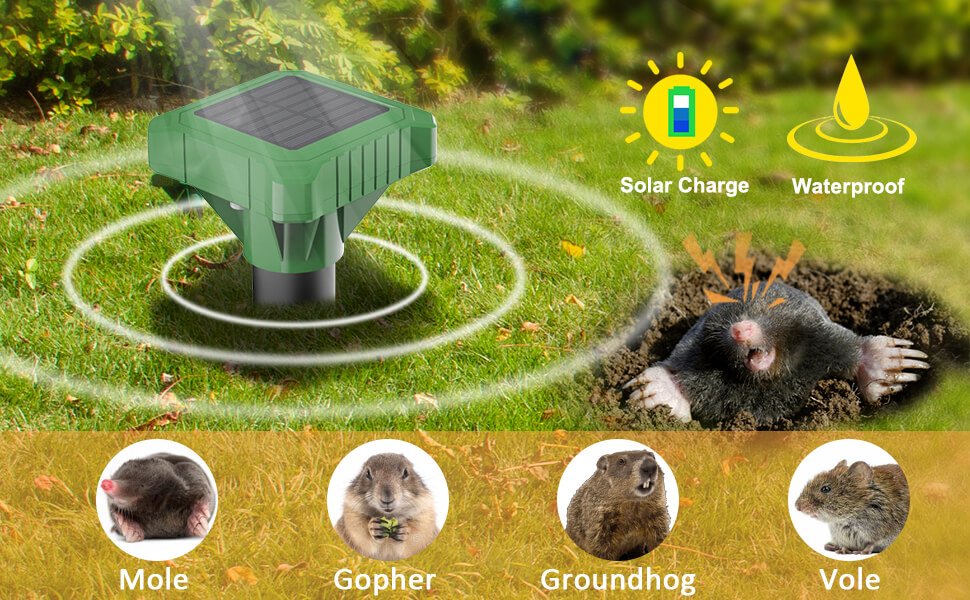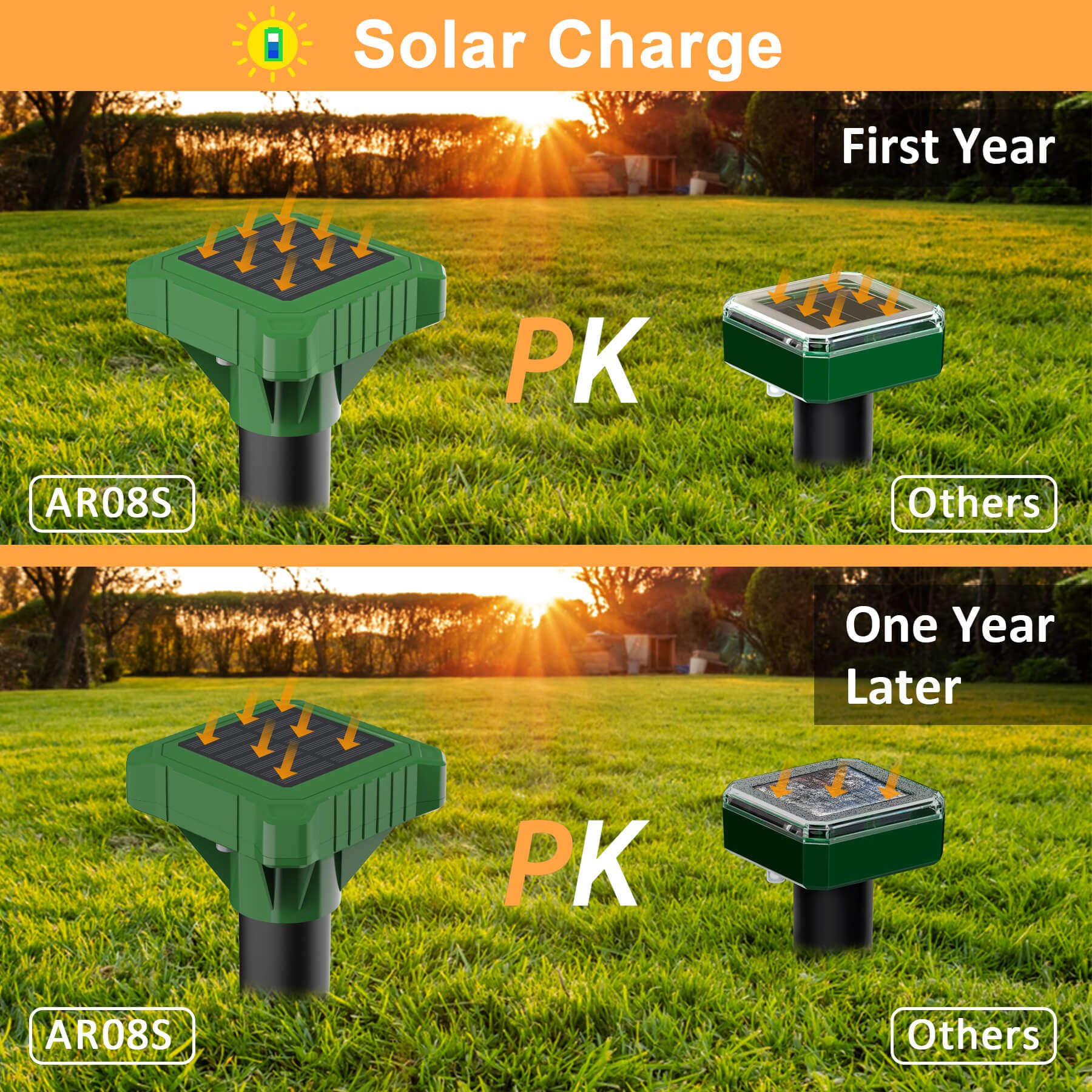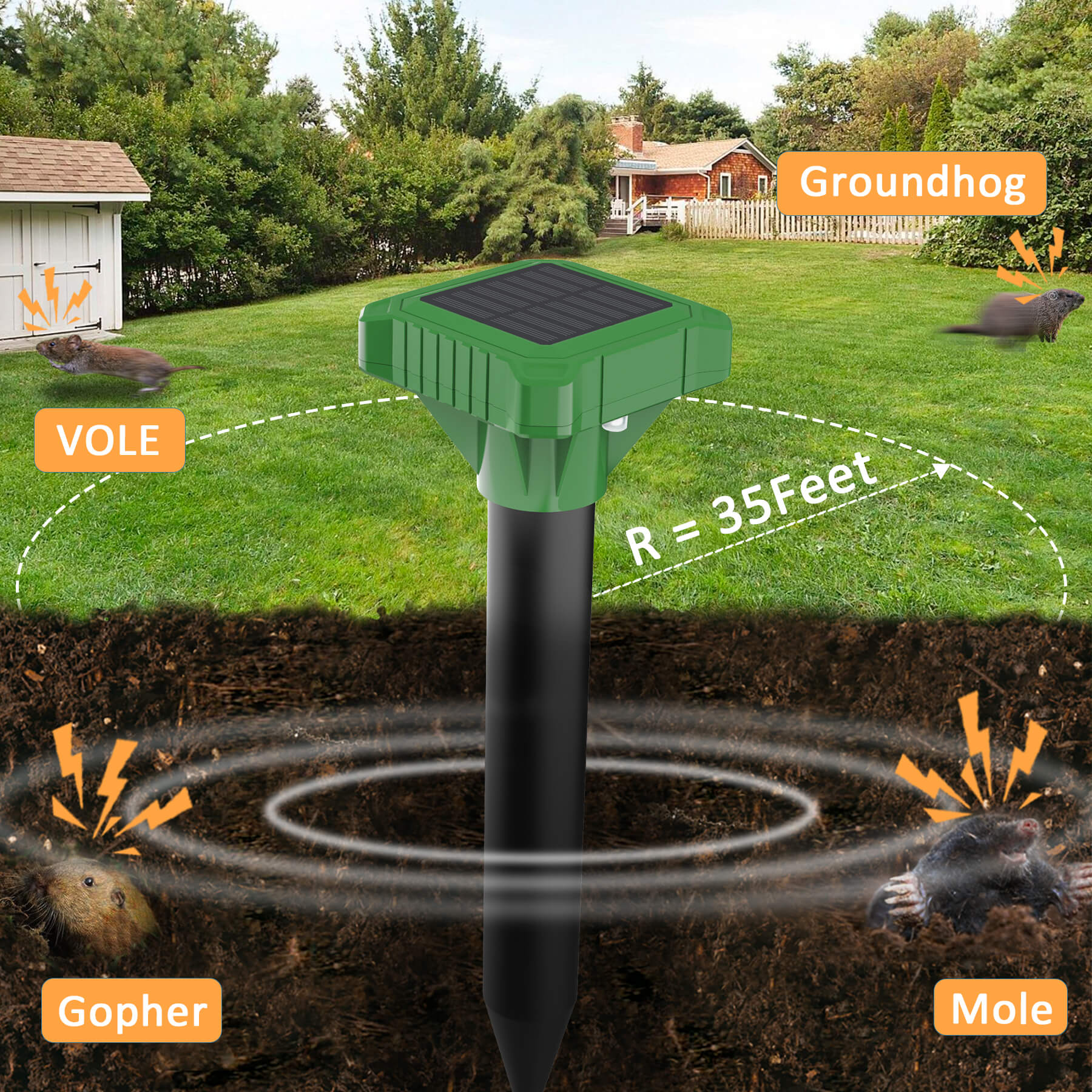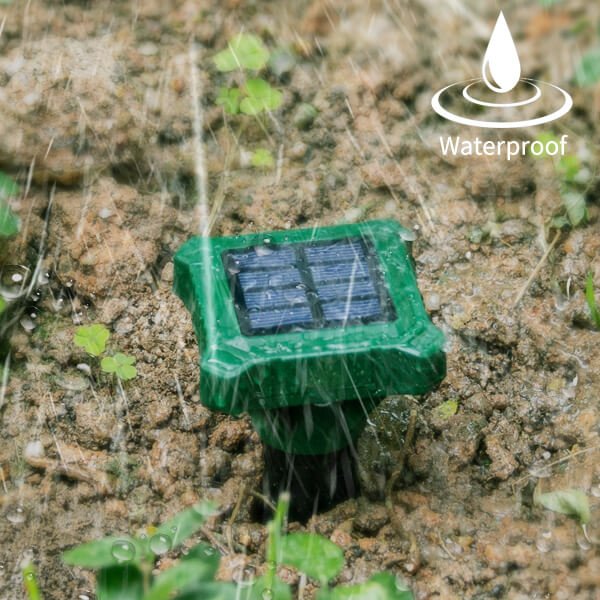Originally published at: Do solar mole repellers work? - Thanos Home
Nothing is as annoying as having vegetable gardens or lawns that you have invested so much time and energy in being destroyed by uneven holes and tunnels.
Most times the culprits of these unnecessary excavations are small partially blind insectivores that spend most of their lives underground. They are called moles and they can be found across continents like Asia, North America, and Europe.
Moles have a long, thin, hairless pink snout (except for the star-nosed species), relatively long claws at the end of wide forepaws, webbed feet, and a round body that is covered by black or dark grey fur.
They can wreak a lot of damage to any environment that they find themselves in. They spend a lot of their time in their underground holes that are connected by a maze of tunnels.
All that digging does not do your lawn or garden much good because they often leave large mounds of dirt on the surface of the soil. They might not be the most aggressive pests to have around but they sure do have a significant nuisance factor. This is probably why you are looking for a way to eliminate them.
Now, moles are often mistaken for voles so it is important that you are clear about the difference between the two before you embark on a war.
These pests mostly eat earthworms, grubs, and a host of other insects which is why they spend most of their time underground where some of these insects dwell. Voles on the other hand feed on plants (their roots and bulbs included) and tree bark.
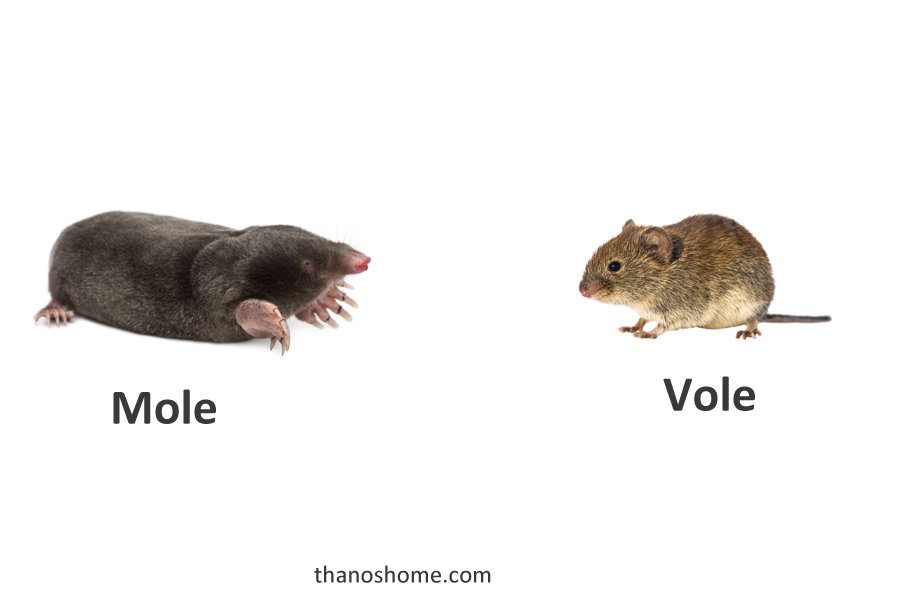
Types of Moles
There are different types of moles species but here are some of the most popular types:
The Eastern Mole
This is arguably the most common mole in the U.S. The adult Eastern mole grows to about six inches and it has sleek, dark fur, a long snout, wide forepaws, and “hooded” eyes.
The Star-Nosed Mole
This species of mole can be found along the East Coast. Its name comes from star-like appendages that protrude from the tip of its snout. Since it is partially blind, these appendages help it detect any insects that might be dwelling in the soil.
Shrew Mole
The shrew mole is built differently from other mole species.
For one, it is really very small as it does not grow any further than five inches long. Secondly, it does not have wide forepaws that most moles use to dig the soil underground. This probably explains why it spends a significant amount of time above ground, unlike most moles.
Signs of a Mole Infestation
Like with all other pests, there will be some telltale signs that should let you know when
you have a mole issue. Here are some of them:
Molehills
Molehills are the obvious sign that you have moles working overtime as excavators underneath your garden or lawn.
Not to be ignored, molehills are essentially small heaps of dirt that you’d see around where moles dig their tunnels. The molehills are deposits for the dirt that used to be where the tunnels are and they vary in size depending on the mole and the kind of soil at the location.
The thing is once you find molehills around then you most likely have a mole or moles around somewhere. Now gophers also make “hills” or dirt mounds but the thing is that their dirt mounds are a lot closer to each other. With molehills, you’d find them a few feet apart from each other.

Tunnels
This is another obvious sign that you have a mole infestation on your hands.
There are two types of tunnels that mole often burrow underground. The first is the travel tunnel that you might find along the sides of the property. Travel tunnels are straight and they run deep underground.
The other kind of tunnel is the feeder tunnel that moles use to track the insects that they prey on.
They follow the path of the moles as they search for food, so these tunnels are often mazy. The moles use these tunnels until they no longer find insects, and since moles damage plant roots when making these tunnels, there are often traces of dead or dying grass.
Plant Damage
One downside of a mole infestation is the damage done to plants as moles search for insects underground. As they dig through the soil, they excavate dirt and displace the bulbs and roots of any plants, shrubs, and trees in their way.
If this happens around a garden, lawn, or farm where you cultivated the plants, shrubs, and trees, you’d be far from thrilled at the sight of the damaged plants that soon die off after having their roots being exposed.
But, in most cases, you’d see loads of dead plants around the areas where the moles are working.
Why Do I Have Moles Around
If you have moles around, then you probably have something that they want, and it could be
any of:
Food
Moles are insectivores with a preference for earthworms, grubs, centipedes, and a host of bugs. They take the time to create intricate tunnels searching for insects that they eat in large quantities. So if you find mole tunnels along fence rows, paths, hedges, or the edges of the building, they are looking for food.
Food is the number one reason why you have moles around your environment. Most moles are not after the crops and trees in your garden or lawn. The voles are.
You’d find moles around your garden because of the range of insects that attack the plants. So in a sense, moles can be seen as beneficial pests because they prey on insects that might be harmful to the plants in the garden.
A Great Ambiance
Moles love cool, damp soil that provides an environment for them to regulate their temperature. So they don’t mind digging up tunnels just about anywhere they believe they can get such a great ambiance.
Are Moles Dangerous?
Yes, they are.
Moles are believed to spread parasites like ticks, mites, and fleas. So a bite from a mole can transmit rabies. We recommend that you keep you and your pets safe from any mole you might find around. You never know what it is packing in its bite.
Moles can cause structural damage to the soil around you. This is because all that free excavating work they do around your house takes away the layer of soil that keeps the topsoil firm. The implication is that the ground around you can cave in when under some pressure. This could lead to injury to you, your family members, neighbors, or any pets around.
Then there is the damage done to the soil and the plants around.
Besides the ugly look that molehills lend to residential and commercial businesses, the vegetation is always worse off when there is a mole infestation. This is why you need to get rid of them ASAP once you detect their presence around you.
What Is The Fastest Way To Get Rid Of Moles In Your Yard?
Most moles spend a lot of time underground, so getting rid of them might be a tad challenging.
That said, here are several devices you might want to try if you are looking to eliminate moles around the house:
Mole trap
As the name suggests, a mole trap is used to trap and kill moles.
Owing to the nature of these animals, there are mole traps designed for above-ground and underground use. In addition, some traps are designed to be staked underground and primed.
So once a mole touches the trap, it sets off the mechanism that impales and kills or injures it. You can then take out the trap, remove the dead animal, and then re-use the trap.
Because these traps can be used to kill moles and certain animal rights protection laws in certain districts, you will need to be sure that it is legal to use mole traps in your area.
Another kind of these traps come in a box-like shape that also goes into their tunnels.
It is a more humane trap as you can take out the box with the trapped animal, which you can take to a different location. Thankfully these devices are common and are readily available online and offline.
These devices come with directions on the best way to use them, and once you follow them to the letter, you’d be sure to get rid of the moles easier and faster.
Here’s a tip. Change the locations of the traps often to get as many of them as possible.
Mole Baits
Moles enjoy eating earthworms and grubs, so these insects can be used to bait and kill the moles. The idea is to get bait shaped like these insects and fill them up with poisons. So when moles try to eat the bait, they get poisoned in the process. That is one way.
Another way to bait moles is to place any of their preferred insects in a box with only one open end underground. So when the mole tries to get to the insect. It gets trapped inside the box. You might have to do some digging as these baits are more effective when placed into the tunnels.
However, the poisoned bait method is not the best option to get rid of moles if you have pets around. The reason is that the pet can directly get poisoned via contact with the poisoned bait or indirectly eat a poisoned mole.
You might be interested in the following article
Mole repellent
A mole repellant is a device that is designed to repel moles.
Unfortunately, moles spend a lot of time underground, so for your mole repellent to work, it needs to be appropriately used for you to get the desired results. You might even opt to use more than a mole repellent or mole chaser to get the job done.
The mole repellent is pretty popular because it eliminates the possibility of you or your pets getting poisoned. You also do not need to keep checking or relocating traps. There are loads of DIY and commercially made mole repellents that you could try your hands on.
Here are some of them:
Ultrasonic Repellents
Sonic repellents use ultrasonic sounds to ward off any mole within the radius of the frequency emitted by the device. So you get it well situated in the ground and let it emit those high-frequency sounds that moles hate. Thankfully, humans cannot hear these sounds, so you are safe.
Your pets (depending on the type of pet) are also safe, although it might take them some time to get used to the devices.
Recommend to buy Thanos Sonic mole repellent
The Thanos® Solar Sonic Mole Repellent uses sonic audio pulse waves to penetrate the earth and generate a particularly unpleasant sound for burrowing pests.
Granulated Repellent
This kind of mole repellent contains a blend of mole repellent granules that are obnoxious to moles. Some of these include castor oil, citronella oil, and garlic. When using this type of mole repellent, you must stick to the directions that come with the product.
Liquid Repellent
Liquid mole repellents mostly contain ingredients that moles find repulsive, like wintergreen, garlic, eggs, fish oil, and clove.
Gassing
This is a more complex option as you might not have the tools to make a gas bomb that releases gases that kill moles. The gassing method is executed by placing gas bombs or tablets in the tunnels that the moles frequent. We recommend that you strictly follow the directions that guide the use of these products.
This is especially important if you have outdoor pets that love to play around your yard.
Some of the gases are a no-no if you have pets or children around. Gassing is a more extreme pest control method and less popular mole repellent.It should be used as a last option or left to a pest control professional.
DIY Mole Repellent
Some of the most common DIY mole repellents use any of castor oil, tar, coffee grounds,tobacco, and red pepper. These are natural mole repellents that can be applied using a spray bottle and some water
What Are Solar Mole Repellers
A solar mole repeller is a sonic mole repellent that emits an ultrasonic sound that can be troubling to moles.
Any mole within the radius of such sound waves is so disturbed that it runs as far as possible from it. Unlike its electric counterpart, the solar mole repeller is powered by solar energy from the sun.
The device is a popular method of controlling moles because it is low maintenance and is easy to use.
It is designed like a disc affixed to a stake, so all you need to do is to drive it into the ground and let it do its thing. In addition, with a solar mole repellent, you don’t need to worry about having toxic materials that could poison you, your family members, neighbors, friends, and pets.
This pest control device gives you the option of controlling moles using an eco-friendly gadget powered by clean, renewable energy. It is a win-win situation where you get rid of a pest without polluting the ecosystem.
You also do not have to bother with the cost of powering the solar powered device because the sun provides the energy it needs for free.
Some solar mole repellents have aesthetic values as they come with LED lights that give the yard some extra beauty, especially if you have several of them around.
The best part about solar mole repellents is that they can help repel pests like snakes, other rodents, gophers, voles, shrews, and other underground burrowing rodents.
https://thanoshome.com/product/solar-sonic-mole-repellent/
How Do Solar Mole Repellers Work
Moles like most burrowing animals depend on their sense of touch and hearing to compensate for their poor eyesight. So they have a very acute sense of hearing which also makes them extra sensitive to sounds.
Solar mole repellers exploit their acute sense of hearing against them.
These devices are designed to emit a high pulse frequency and sonic vibrations that literarily drive the moles crazy. The experience can be likened to listening to grating sounds over a football stadium’s speakers.
The discomfiting effects of the ultrasonic frequencies and vibrations are so strong that the moles are forced to move as far as possible to get away from the high-frequency sound.
The solar mole repellers are powered by photovoltaic cells assembled in a solar panel placed around the top of the device. So when the device is placed under direct sunlight, these cells draw sunlight which is transformed into electrical power.
Since they are powered by solar energy, most solar mole repellents do not need wires, cables, or electrical outlets o you don’t have to worry about the extra cost.
Some of them are fitted with rechargeable batteries that can power the device for a few days. So the device can still work during that period when there isn’t sunlight to power the pest repeller.
The Thanos® Solar Sonic Mole Repellent uses the solar power to send out bursts of strong sonic pulse waves at the exact frequency burrowing pests are highly susceptible to.
This drives them from the area the device is located in and keeps them away for the duration it’s active.
Will Solar Mole Repellers Work?
Yes, they will.
As long as you follow the directions on how to use the products, you will repel the moles you have around the yard.
Now there are arguments and counterpositions about the efficacy of solar molar repellers, and this is understandable as there might be quite a few factors responsible for that.
It might be that the number of solar repellers is not enough to cover the entire space, so the ultrasounds are not effective enough to repel the animals.
There is a reason why a solar mole repeller has a specific working range and have to be set a certain distance apart from each other. There might also be issues with the device itself that might affect its operations.
Some users of solar powered mole repellers forget their source of energy and often set them up in heavily shaded areas. In such scenarios, the devices do not have enough sunlight to power them, so they won’t emit the ultrasonic sounds and vibrations needed to repel the moles.
Then again, there is the possibility of the moles getting accustomed to hearing ultrasonic sounds from a specific area and finding ways to circumvent those areas. Be that as it may, there are a lot of folks who have success stories about solar mole repellers.
To get the most of solar repellers, we recommend that you get the Thanos solar mole repellers for your yard or home. So factor in the working range and ensure that you get solar powered repellers that cover that area effectively. Just so you know, some of the best solar mole repellers need to have a 48ft radius to be effective.
Some folks believe that the best solar mole repellers have with aluminum stakes and are effective within a large radius. So you might want to try them out next time you are out shopping for a solar repeller.
We also suggest that you take the time to change the position of the mole repellers every other day so that the moles are not able to adjust to the sounds easily.
Bear in mind that the moles will continue their work outside the area covered by the mole repellers. So you want a mole repellent that offers coverage that keeps them as far away as possible from you.
The location where even the best mole repellent is set up also matters.
Clay soil is believed to have an amplifying effect on ultrasound. Conversely, sedimentary rock, a high concentration of large stones, and large rocks will impede the movement of ultrasound waves and vibrations.
So a solar pest repeller set up in such an area will not be effective against the moles in the vicinity.
The solar mole repeller is considered one of the most humane pest control methods to tackle a pest problem and it can be effective when used the right way.
After all, if they were not meeting any needs, why would there be a thriving industry for them?
How Long Do Solar Mole Repellers Last?
It depends on the brand and the kind of solar powered mole repeller that you buy.You might get a clue from the manufacturer claims on the eco-friendly device.
Do Ultrasonic Repellents Work On Moles?
Yes, they do.
Ultrasonic mole repellers work based on the same principle as a solar powered mole repeller as they both emit ultrasonic sounds, which vex and confuse moles.
So if you installed an ultrasonic mole repellent, the odds are that it is repelling any moles within the vicinity.
How to Choose the Best Solar Mole Repeller
There are a lot of mole repellents out in the market.
So it would be best if you considered the following factors before settling for the best solar powered mole repeller:
- Your location and climate
- The charging period
- The working range
- The size of the area
- How sturdy the design of the repellent is
- The price and warranty for the product
- Easy installation
https://thanoshome.com/product/solar-sonic-mole-repellent/
Conclusion
Moles might not be the scariest pest to have around, but they are capable of wreaking some havoc if you give them a chance.
Most people who are on to their destructive potential are always looking to eliminate them. Unfortunately, some of the options they explore might break animal rights laws.
Thankfully,there is a safe, eco-friendly,budget-friendly, and effective option in solar mole repellents. Although some folks argue that they are a waste of time, solar mole repellers do work.
The only thing you have to do is to follow the directions in the complete buyer’s guide
You might be interested in the following article
